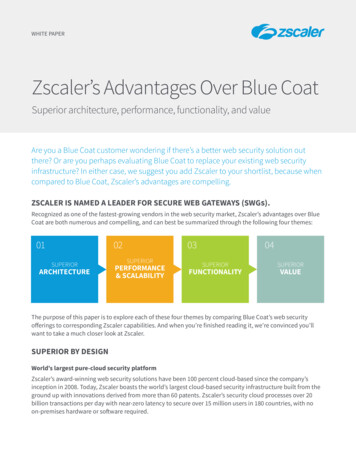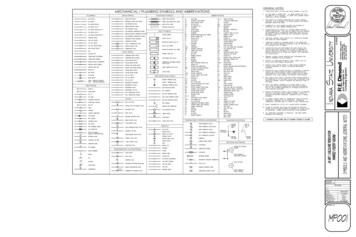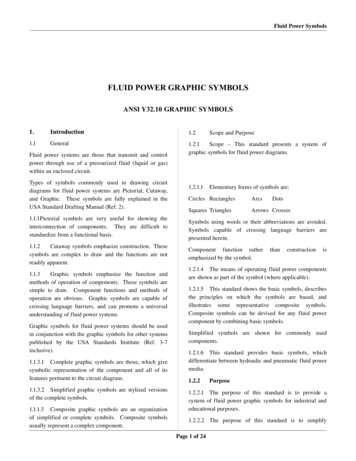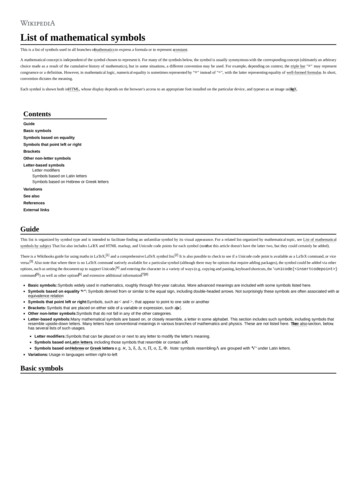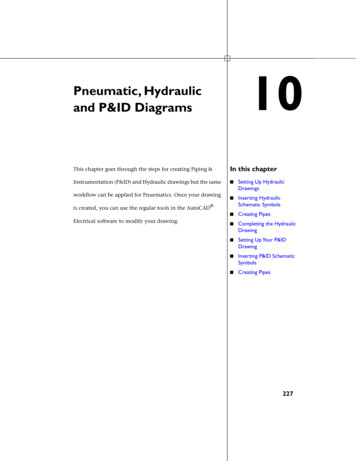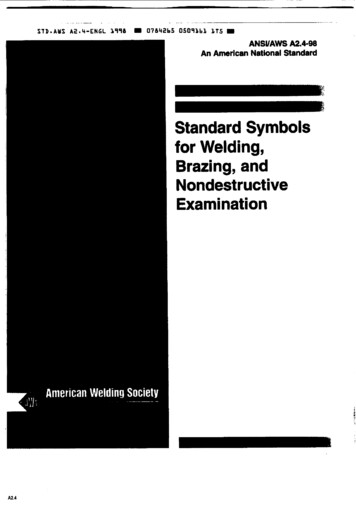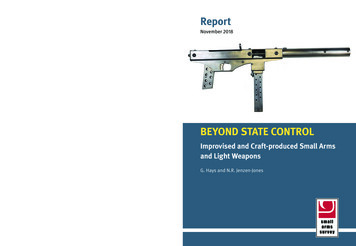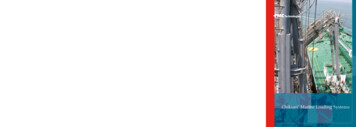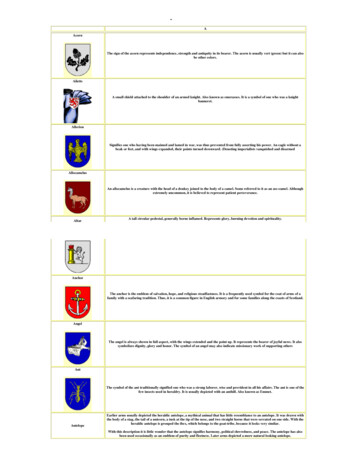
Transcription
SymbolsAAcornThe sign of the acorn represents independence, strength and antiquity in its bearer. The acorn is usually vert (green) but it can alsobe other colors.AilettsA small shield attached to the shoulder of an armed knight. Also known as emerasses. It is a symbol of one who was a knightbanneret.AllerionSignifies one who having been maimed and lamed in war, was thus prevented from fully asserting his power. An eagle without abeak or feet, and with wings expanded, their points turned downward. (Denoting imperialists vanquished and disarmedAllocamelusAn allocamelus is a creature with the head of a donkey joined to the body of a camel. Some referred to it as an ass-camel. Althoughextremely uncommon, it is believed to represent patient perseverance.AltarA tall circular pedestal, generally borne inflamed. Represents glory, burning devotion and spirituality.AnchorThe anchor is the emblem of salvation, hope, and religious steadfastness. It is a frequently used symbol for the coat of arms of afamily with a seafaring tradition. Thus, it is a common figure in English armory and for some families along the coasts of Scotland.AngelThe angel is always shown in full aspect, with the wings extended and the point up. It represents the bearer of joyful news. It alsosymbolizes dignity, glory and honor. The symbol of an angel may also indicate missionary work of supporting othersAntThe symbol of the ant traditionally signified one who was a strong laborer, wise and provident in all his affairs. The ant is one of thefew insects used in heraldry. It is usually depicted with an anthill. Also known as Emmet.AntelopeEarlier arms usually depicted the heraldic antelope, a mythical animal that has little resemblance to an antelope. It was drawn withthe body of a stag, the tail of a unicorn, a tusk at the tip of the nose, and two straight horns that were serrated on one side. With theheraldic antelope is grouped the ibex, which belongs to the goat-tribe, because it looks very similar.With this description it is little wonder that the antelope signifies harmony, political shrewdness, and peace. The antelope has alsobeen used occasionally as an emblem of purity and fleetness. Later arms depicted a more natural looking antelope.
AntlersAntlers represent strength and fortitude. See also HORNSAnvilThe symbol of the anvil born on a shield or coat of arms is a symbol of honor. It may indicate that the first bearer was a smith.AnnuletThe annulet is a plain ring. As a closed circle, it is symbolic of continuity, wholeness, and fidelity. It also signified that the bearer hadroyal favor and protection. The Romans are said to have worn a ring as a sign of knighthood. The annulet may have been used toindicate that the bearer had the superior qualities of a knight. In some circles an annulet represented riches. Also, on English armsan annulet was sometimes a sign of the fifth son.The ape is considered a symbol of sin, malice, craftiness and lust. It has been suggested that the symbol was to serve as a reminder tothe bearer of one's morals, ethics and religion and that he bore a moral obligation to conquer all sins.ApeThe ape is not a very common symbol in heraldry but when it is found it is usually "collared and chained," with the collar encirclingits waist rather than its neck.The Fitzgerald crest has an Ape.AppleApples symbolize liberality, felicity, peace, and salvation. All kinds of fruit were considered to be symbols of God's kindness and asymbol of the goodness of providence.ArchMay be single or double, i.e. springing from two of three pillars. Symbolizes a governor or magistrate.ArmArm - bare (naked) represents an industrious person, one who believes in and engages in hard work.Arm in ArmourRepresents a person who has served as a leader or has the qualities of leadership. A person fit for high deeds.
ArrowThe arrow is said to be a weapon "destined for avengement." Arrows symbolize martial readiness. If depicted with a cross, isrepresents an affliction as the result of war. In the case of Polish armory, bows and arrows signify a man resolved to challengehimself to the utmost in battle, and who is prepared to fight to the death if necessary.AssRepresents patience and humility. The ass may also be associated with one who fulfills their Christian duty.AxeExecution of military duty. See also BATTLE AXEBBadgerThe badger is an animal noted for his fierceness and courage in fighting to defend his home. The symbol of the badger representsbravery, perseverance and protection. It is more typically found in the armor of England than that of other nations.BaguettePledge of fidelity and faithfulness.BagwynThe bagwyn is an imaginary animal with a head drawn like a heraldic antelope, the body and tail of a horse and the horns long andcurved backwards. It is thought to symbolize one who displays fierceness and bravery in the defense of king and country.BalanceBalances have traditionally been a symbol of fairness and justice. They were adopted as a symbol by the Company of Bakers inLondon and are still used today as a symbol of an unbiased court system.BannerThe banner is a square flag painted or embroidered with arms. The size is proportioned to the rank of the bearer. It is a symbol ofvictory and self-assertion. Banners on the shield or as a crest often refer to a special military action where a flag, or possibly thebearer, was captured, or as an indication of gallant service. Banners may also indicate that a member of that family was once astandard-bearer. As a charge the banner is usually hung from the walls of a castle or carried by the figure of some type of animal.Banners are sometimes mistakenly referred to as flags or standards. The principle difference between a banner and a flag, standardor pennon etc. is that a banner is always square while the others are elongated.
The banner of an emperor is prescribed to be six feet square, that of a knight five feet, that of a prince or duke four feet, and that ofa nobleman of any rank from marquess to baron three feet, that of a knight banneret was still smaller.BarnacleA barnacle, or pair of barnacles may represent one who was a farrier. It has also been suggested that it may represent one who wasable to extract confession from the enemyBarrelBarrels, or casks, were commonly used to hold beer or wine. It possibly symbolizes that the original bearer was a vendor of beer orwine, or an innkeeper. It occurs in the insignia of the BREWERS' and VINTNERS' Companies, as well as in the arms of a fewfamilies. It is often used as a pun on names ending in 'ton,' for example the crest of Hopton depicts a lion hopping on a tun. Alsoknown as "Tun".A Cooper was a barrel maker.BarryRepresent military belt or girdles of honour.Bar-ShotAn instrument of war. Represents one who has used it in war, or one who has experienced the terror of such a weapon in war.BatThe bat may was an intimidating heraldic symbol used to inspire fear in enemies. It is to be sable in color (black), displayed, withwings open and facing the observer. It is sometimes referred to by the old name rere-mouse. Quoted from Shakespeare's AMidsummer's Night Dream, "Some war with rere-mice for their leathern wings."BatonA token of authority.Battering RamThe battering ram is an ancient war machine that symbolizes determination, especially in war. The charge of a battering ram mayhave also been granted to someone who was greatly skilled in its use, or who was in charge of it during wartime. It does not resemblea real battering ram. Instead, it consists of a ram's head on the end of a log, with ropes encircling it and hooks attached to them,presumably to hold it up.BearThe bear is the emblem of strength, cunning, and ferocity in the protection of kindred. A bear is also a symbol of healing andpersonal health and bravery. The bear is usually muzzled but not always. Sometimes only the paws of a bear are used as a symbol.BeaverThe beaver denotes industry, perseverance and determination.
BeeThe bee is a sign of industry, creativity, wealth, diligence and eloquence. The Egyptians used it as a symbol of regal power. Inarmory, it is used to represent well-governed industry. The bee is the most popular insect found in heraldry, and is usually shownwith the beehive.BellBells signify the power of church-bells to disperse evil spirits in the air and their summoning of guardian saints and angels. A hawk'sbell denotes one who was not afraid to signal his approach in either peace or war. A Canterbury bell is a sign of pilgrimage.BendThe bend is a broad, diagonal band across the shield representing either a scarf worn like a sash, or the shield suspender of a knightor military commander. Some claim it represents a scaling ladder. It has often been granted to those who have distinguishedthemselves as knights. The bend signifies defense or protection, and is a bearing of high honor.The bend sinister (extending from upper right to lower left) was once used on occasion as a mark of illegitimacy though this is notcommonly the case.BerriesRepresent liberality, felicity and peace.BezantThe bezant was the coin of Byzantium (Constantinople). It is represented by a gold roundel (a plain gold circle). It is thought that thebezant, was introduced into armory at the time of the Crusades. It represents justice and equal dealing among people. The sign ofthe bezant is borne by those deemed worthy of trust and treasure.BilletThe billet represents a letter folded for transmission. It has the form of a brick-shaped rectangle and it occurs more frequently withmany small billets on the field. It is thought to indicate one who whose words and deeds were deemed trustworthy. It has also beensuggested that lawyers and men of letters often adopted the sign of the billet.BirdBirds of all tinctures (blackbird, bluebird, red bird) represent the peace and affection of home and family.Bishop's MitreChurch Authority.
Black MoorRepresented by a dark-skinned head. It is often used as a crest. The Blackmoor indicates one who fought in the crusades with deedsof prowess - or "took the head" of many of the enemy. See also MOORBoarThe boar is the symbol of bravery. A champion among wild beasts, it encounters enemies with nobility and courage, and, thus, hascome to signify the traits of bravery and perseverance. The boar is a fierce combatant when at bay and ceases fighting only with itslife. Therefore it was given only to those considered fierce warriors.In Ireland the boar is one of the most popular charges. The meat of the boar was considered to be food of the Celtic Gods. Thesymbol of the boar was worn in battle as a charm against injury.Boar's HeadRepresents hospitality, or one who is hospitable.BookIf open, the book signifies manifestation. If it is closed, it signifies counsel. Books are also considered a symbol of learning. The bibleis frequently mentioned as the book represented in the crest or arms, though it would not appear any differently than a regularbook.BorderedThe bordure is, as it sounds, a fairly wide border around the outside of a shield. It is usually a mark of cadency, signifying a youngerson or brother. It also symbolizes an augmentation of an honor.Except in England a wavy border is a mark of illegitimacy. In Scotland the bordure compony (border with 16 pieces) serves the samepurpose. These were not considered to be marks of dishonor. It was carried over from the days when it was necessary to distinguishthe rightful heirs from others who might have some claim to the family title and fortune. In some instances it was borne when anatural son had succeeded by bequest to the estates of his father.BowsRepresents readiness for Battle.BracketMay be single or double; right angle-shaped support, as in a shelf support.BridgeRepresents a governor or magistrate.
Broom PlantThe broom plant is a symbol of humility. A sprig of this shrub was chosen as the badge of the royal house of Plantagenet, who aresaid to have derived their surname from the circumstance of one of their ancestors having worn a branch of broom is his helmet,either by way of penance, or in token of humility.BuckRepresents a male deer. Indicates one who is skillful but will not fight unless seriously provoked. Once fighting becomes necessarythe stag is said to down its enemy. It is also a symbol of peace and harmony - an individual who is politic and a lover of harmony. InIreland the buck or stag was one of the most ancient charges and was regarded as the most handsome. It also represents the veryancestors of the Celtic race. see also STAGBucketThough their appearance is quite different, the function and symbolic meaning of a water- bouget and a bucket are similar. Thecharge of a bucket was conferred on those who had supplied water to an army or a besieged place. The bucket is merely the moremodern way of transporting water. The common well bucket is usually the type born in arms, but they can also be hooped or havefeet.BuckleThe buckle signifies self-defense and protection, as well as victorious fidelity in authority. Buckles may be square, round, orrectangular in shape.BullA bull, also referred to as an ox, in a coat of arms, on a crest or a shield, represents valor and magnanimity, bravery and generosity.The horns represent strength and fortitude. The calf is an ancient heraldic symbol traditionally associated with the characteristics ofpatience, submissiveness and self-sacrifice.Bull's HeadBulls' heads are perhaps more commonly found than the animal itself. Generally the horns are blazoned of a different tincture.Represents valor, bravery, and generosity.ButterflyPsyche & FreedomCCaduceusSymbolizes medicine.CaltrapA caltrap or galtrap, and sometimes a cheval trap, was an ancient military instrument with four points, arranged so that when it wasthrown on the ground, it always landed on three of the four points, with the fourth pointing up. Caltraps were scattered in the path
of an enemy to impede and endanger the horses. The emblem of the caltrap indicates a fierce warrior in battle.CamelThe camel signifies temperance, patience and indefatigable perseverance. In ancient times it may have been used as a sign of royaltyand dignity.CandlestickRepresents light and life and spirituality.CannonThe cannon is a symbol well bestowed on those who have dared their terrors in sieges and battles. See also GRENADESCap of MaintenanceGranted to British peers and Scottish feudal barons (see "Chapeau")CartwheelSymbol of a cartwright or cart maker.CastleThe castle has often been granted to one who has faithfully held a castle for his sovereign, or who has captured one by force orstratagem. The castle symbolizes spiritual power and vigilance on the watch as well as home and safety. See also TOWERCatA symbol of a great cat, or a cat-a-mountain, which refers to a wildcat, puma, or mountain lion. It signifies liberty, vigilance andcourage. There is also a separate reference to a spotted cat. Cats are most common in Scottish or Irish arms.Catherine WheelThe most common heraldic wheel is the Catherine-wheel. According to legend, St. Catherine of Alexandria publicly confessed tobeing a Christian at a feast held by the Roman emperor Maximus. When she refused to renounce her faith, she was beaten andimprisoned. An attempt was made to tear her apart on a spiked wheel, but it fell apart and she was unhurt. The Catherine-wheel isthe emblem of one who is prepared to undergo great trials for the Christian faith. See also WHEELCelestial CrownAs with all crowns, the Celestial crown is an emblem of victory, sovereignty, and empire. It is a visible sign of success, thus the term"crowning achievement," and its significance as the decoration of the ultimate level of rank and power, makes bearing the crown agreat honor. Crowns are also sometimes symbols of God, as He is considered by some to be the "King of all."CentaurCentaurs are well known creatures that are half man and half horse. A centaur carrying a bow and arrow is called a sagittarius.
Both the sagittarius and the centaur are quite common in heraldry. The centaur is a symbol of virility and one who has prevailed inthe field of battle.ChainChains are a symbolic representation of reward for acceptable and weighty service. Chains are often accompanied by crowns andcollars or sometimes with a portcullis (castle gate). This would suggest that the owner of that symbol is chained by a sense ofobligation to the people that he serves or rules. For this reason, chains and collars are also marks of honor for sheriffs and mayors,and formerly, for knightsChameleonRepresents one who is adaptable to the surrounding and his circumstances.ChapletA chaplet is a wreath without stems or ribbon, made of green oak, laurel or other leaves, with four roses. It is a symbol of fame. It isalso known as the crown of joy and admiration.CherubRepresents dignity, glory and honor. May also depict a missionary or the bearer of joyful news.Chess RookA chess-rook is also called a castle, and may have been granted to those who had captured or defended castles. It may also havedenoted one who was skillful in influencing others to act in a manner that he would find beneficial. Thus it's similarity to a chessrook.ChevronThe chevron represents the roof of a house, derived from the French word 'chevron' meaning rafter. It signifies protection. Thechevron was granted to those who had participated in some notable enterprise, had built churches or fortresses, or had accomplishedsome work requiring faithful service.ChimeraThe chimera is a very odd looking creature with the head and breast of a woman, the forepaws of a lion, the body of a goat, the hindlegs of a griffin (the legs of a lion and claws of an eagle) and the tail of a dragon. It is similar to the sphinx. It is said to be cunningand to mislead its enemies because of the woman's head and breast, and then to attack with ferocity.ChiefThe chief is a broad band across the top one-third of the shield that stands for authority and domination of will. The chief has oftenbeen granted as a special reward for prudence and wisdom, as well as for successful command in warCinqfoilA 5-petaled flower. Represents hope and joy.
ClarionAlso known as a rest, it is thought to represent a spear's rest, symbolizing one's preparedness for war.CloudThe cloud, the symbol of the ethereal heights of heaven, represents mystery and the quality of higher truth.CockAs the herald of dawn, the cock is symbolic of the sun. It is also a bird of great courage in battle that will fight, if necessary, to thedeath. Therefore, it is an emblem of a hero, one who battles with perseverance and courage. The cock is also used as a Christianimage of the resurrection.CockatriceThe cockatrice is the king of serpents, with the head and legs of a cock, the wings of a dragon, and a scaly body, also like a dragon,that ends in a long barbed tail. It is sometimes referred to as a basilisk, of which legends say was produced from an egg laid by anine-year-old cock, and hatched by a toad on a dunghill. Its breath and sight were so poisonous that they would kill all who camewithin range. Thus, the cockatrice is a potent symbol of terror to all beholders.CockfishThe cockfish is drawn very much as it sounds with the head and upper-body of a cock terminating in the lower-body and tail of afish. It is said to represent one who performed heroically in a battle at sea.ColumnsColumns symbolize fortitude and constancy. It also implies that its bearer supports others who are weaker. A serpent coiled round acolumn signifies wisdom with fortitude.CombThe comb is the common attribute of certain mythical female beings such as lamias, sirens, and mermaids, whose usual pose is withmirror and comb in hand. It may have sometimes been given to those who were said to have fought or resisted the temptations ofsuch dangerous types. If a comb is shown alone, it more often refers to a wool-comb or the combs used in the textile industry andmay represent one who toiled in that industry.CordonA cordon is the silver cord that encircles the arms of widows.Its institution has been attributed to Anne of Bretagne, widow ofCharles VIII, King of France, "who," says Ashmole(Order if G., p. 126), "instead of the military belt or collar, bestowed a cordon orlace on several ladies, admonishing term to live chastely and devoutly, always mindful of the cords and bonds of our Saviour JesusChrist; and to engage them to a greater esteem thereof, she surrounded her escutcheon of arms with the like cordon." The special isused is to distinguish the arms of widows from those of wives. Later on, knights would wear a cordon on their armour to signify lostcomrades. On a Coat of Arms it is thought to represent an admonishment to live chastely and devoutlyCornetThe crown is an emblem of victory, sovereignty, and empire. It is a visible sign of success, thus the term "crowning achievement,"and its significance as the decoration of the ultimate level of rank and power, makes bearing the crown a great honor. Crowns arealso sometimes symbols of God, as He is considered by some to be the "King of all."
CornucopiaDepicts thankfulness for the bounty of nature's gifts. Abundance and plenty.CrabThe crab is a symbol of great strength and power in gripping and holding. The claws of a lobster are also symbols of prodigiousgripping and holding power in its bearer.Crane/Herron/StorkAccording to legend, cranes lived in a community where individual members took turns standing watch. The sentry crane held astone in one claw so that if it dozed, the falling stone would wake the bird. The crane is a symbol of vigilance, justice and longevity,but nevertheless, there are instances where the crane is shown asleep with its head under its wing, still maintaining its 'vigilance,' asthe stone is termed. It also represents close parental bond. See also Stork and Herron.CrescentThe crescent stands for one who has been "enlightened and honored by the gracious aspect of his sovereign." It is also borne as asymbol of the hope of greater glory. Crescents also represent the moon that lights the night sky for travelers, though it does notresemble the shape of a crescent moon very closely. In English arms it was also a mark of cadency signifying the second sonCrocodileThe crocodile was a mysterious and legendary beast to most people in ancient times and it was a powerful emblem of fury andpower. Crocodile is frequently interchanged with alligator.CrosierRepresents one who was a high official in the church or an Archbishop.CrossRepresents faith and the Church.CrossbowReadiness for battle or war.CrowA crow signifies a settled habitation and a quiet life. Also known as the Cornish Clough. See also RAVEN
CrownThe crown is an emblem of victory, sovereignty, and empire. It is a visible sign of success, thus the term "crowning achievement,"and its significance as the decoration of the ultimate level of rank and power, makes bearing the crown a great honor. Crowns arealso sometimes symbols of God, as He is considered by some to be the "King of all."Crown of ThornsRepresents one who has suffered adversity.Cup/ChaliceIndicates one in service to the sovereign.CushionCushions on one's arms are considered marks of authority. They actually appear to be quite ancient symbols, especially in Scottishheraldry.Cypress TreeThe cypress tree is the symbol of death and eternal life thereafter.DDaggerThe symbol of victory, justice, and military honor.DecrescentA crescent with horns to the sinister (backwards). Represents one who has been honored by the sovereign. A hope of greater glory.DiceSymbolizes constancy, wisdom, verity probity, and equity.DolphinThe dolphin is an emblem of safe travel, as well as kindness and charity, particularly to children. It is also believed to representswiftness, diligence, salvation and love. Older heralds considered it the king of fish, just as the lion was king of the beasts and theeagle was king of the birds.
Double Headed EagleSymbolic of the protector . Also the joining of two forces.DoveThe dove is a symbol of the soul and of the Holy Spirit. It signifies peace, gentleness and purity. In armory, the dove signifies lovingconstancy and peace. In heraldry the dove is always depicted with a slight tuft on its head, possibly to distinguish it from a woodpigeon, which is very much like it. A dove is often shown with an olive branch in its beak, representing the harbinger of good tidings.The dove is frequently found in the arms granted to Bishops. In Ireland the Dove is regarded as the bird of God.DragonA dragon is supposed to have a keen sight, which enables it to guard treasures well. It is also said to be the most valiant of creatures;therefore, the dragon is a symbol of a most valiant defender of treasure. Dragons were perceived as powerful, protective, andfearsome, and they were valued for their warlike qualitiesDrumWar DrumDropsSymbolic of one who has endured torrents of liquids as in the course of battle. The type of liquid is determined by the color of thedrops:Or (yellow) goldAzure (blue) tearsVert (green) oilArgent (white or silver) waterSable (black) tar or pitchGules (red) bloodSEE also GOUTTESDuckDucks can elude their enemies in many ways, either by flying, running, swimming or diving for cover; therefore, they are a symbolfor a person of many resources. Ducks may be referred to by many names such as drake, mallard, teal, eider-duck, moorhen, andsheldrake. See also GANNET and MARTLET.EEagleThe eagle symbolizes a man of action, occupied with high and weighty affairs. It was given to those of lofty spirit, ingenuity, quickwit, speedy in apprehension and judicious in matters of ambiguity. The wings signify protection, and the gripping talons symbolizeruin to evildoers. The eagle is believed to represent a noble nature, strength & bravery. The eagle is also associated with the sun. As aChristian symbol, the eagle represents salvation, redemption and resurrection.In Ireland it was regarded as one of the "demons of the air", making it a very powerful symbol.Eastern CrownThe eastern or antique crown was believed to represent the crown worn by Oriental princes. Thus it was given to those haddistinguished themselves in service in the East and it is also often born by merchants, the association being that they are like themagi.ElephantThe elephant, its head or tusks, is considered a symbol of huge strength and stature, wisdom, courage, longevity, happiness, royalty,good luck, and ambition.
EnfieldThe enfield is a mythical beast with the head and ears of a fox, chest of a greyhound, forelegs of an eagle, body of a lion, and hindlegs and tail of a wolf. It is said to have protected a fallen chieftain's body until proper burial.ErmineErmine - White fur with Black spots. Denotes Nobility.ErminesErmines-Black fur with white spots. Denotes NobilityEscallopBefore the days of heraldry the symbol was the emblem of St. James, the patron saint of pilgrims and consequently the escallopbecame a badge worn by all pilgrims attached to hook or hat. In armory it signifies a soldier who had made long journeys or voyagesto far countries, or gained great victories. It is an emblem of safe travel. It is also an emblem of fidelity because its shells, onceseparated, can never be rejoined.EscarbuncleThe escarbuncle is a symbol of supremacy. In ancient warfare iron bands stemming from the center and radiating outwards wereused to strengthen the shield for better protection in battle. Over time the pattern made by these bands was adopted as a charge andcalled in heraldic terms an escarbuncle. It is also a representation of a brilliant gem.EstoileThe estoile symbolizes honor, achievement and hope. It also symbolizes celestial goodness and one who is noble. In some cases, a starmay represent a falling star and denote a divine quality bestowed from above, whereby men "shine in virtue like bright stars on theearth." Stars with wavy points are emblems of God's goodness. .EyeAn eye signifies providence in government.FFacesThe fasces consists of a bundle of polished rods bound around a battle-axe. It symbolized one who may have been in control and hadthe power over life and death.
FalconThe falcon or hawk signifies someone who was hot or eager in the pursuit of an object much desired and did not rest until theobjective was achieved. It is frequently found in the coats of arms of nobility, from the time when the falcon played an importantsocial role in the sport of kings and nobles. See also HAWKFeathersFeathers are a very common charge in heraldry, which is not surprising considering that during a tournament helmets were morefrequently ornamented with feathers than with family crests. Consequently, the plume, which is a grouping of five feathers. becamethe actual, inheritable family crest for many families. Feathers signify willing obedience and serenity of mind.Fer de MolineA fer de moline, or mill-rind is the iron clamp in the center of a grindstone that provides support and is used to turn it. It representsindustry and purpose and may also have been used as the sign of a miller. It is sometimes referred to as a "miller's cross. See alsoMILLRINDFessThe fesse is a broad, horizontal band across the center of the shield that represents the military belt and girdle of honor of a knight.It signifies that the bearer must always be in readiness to act for the well being of the people.Fetter LockSome state that the fetterlock is a device for hobbling horses while others say that it is a handcuff or a prisoner's bolt. Whichever itis, it is an emblem of victory. It may have represented someone in the Middle Ages who had taken his enemy prisoner, or who could,by either his prowess or his charity, redeem any of his fellow soldiers ransomed in captivity. It is also referred to as a shacklebolt,shackbolt or manacle.FireballThe symbol of the fireball was bestowed on those who had endured terror while und
Symbols A Acorn The sign of the acorn represents independence, strength and antiquity in its bearer. The acorn is usually vert (green) but it can also be other colors. Ailetts A small shield attached to the shoulder of an armed knight. Also known as emerasses.

